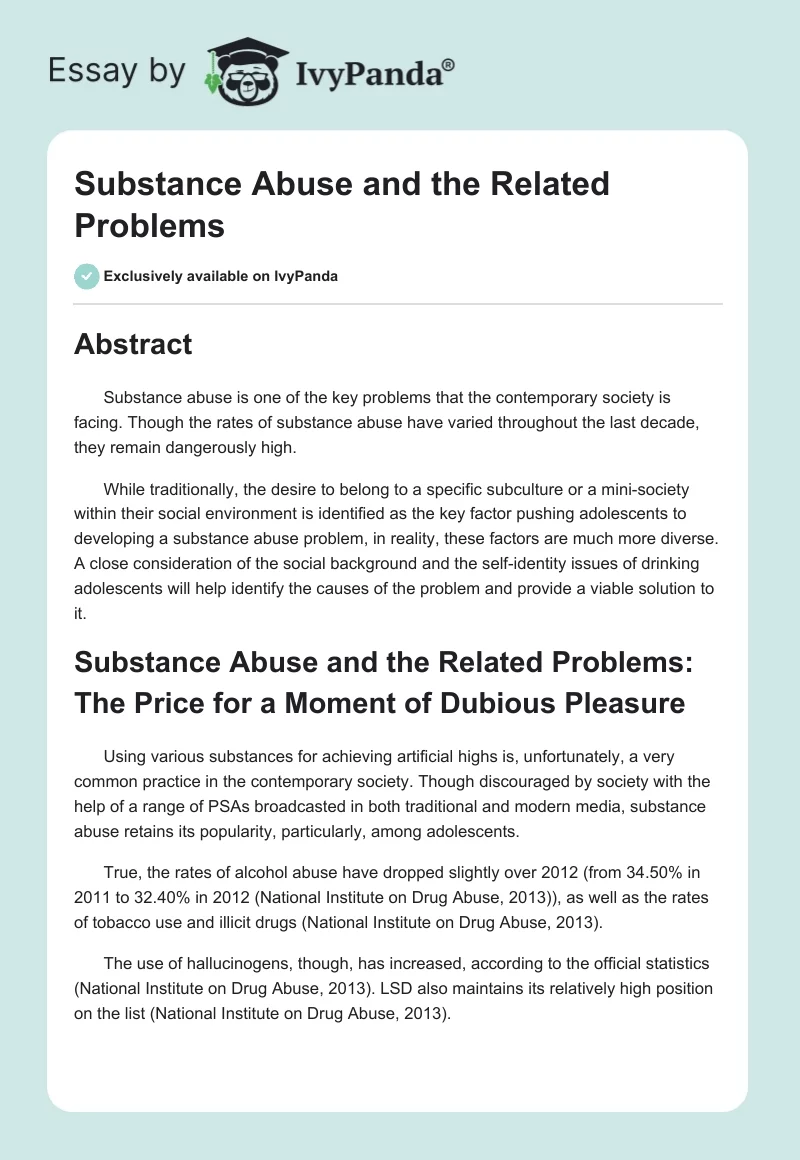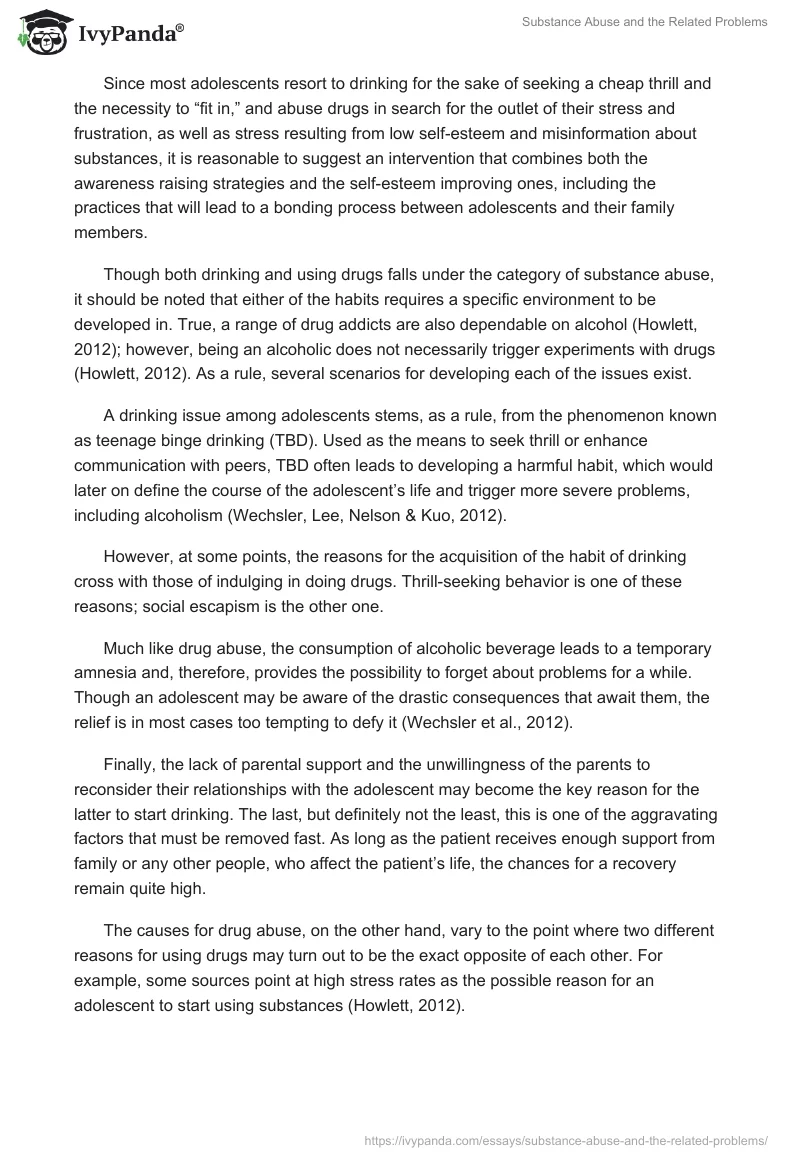Abstract
Substance abuse is one of the key problems that the contemporary society is facing. Though the rates of substance abuse have varied throughout the last decade, they remain dangerously high.
While traditionally, the desire to belong to a specific subculture or a mini-society within their social environment is identified as the key factor pushing adolescents to developing a substance abuse problem, in reality, these factors are much more diverse. A close consideration of the social background and the self-identity issues of drinking adolescents will help identify the causes of the problem and provide a viable solution to it.
Substance Abuse and the Related Problems: The Price for a Moment of Dubious Pleasure
Using various substances for achieving artificial highs is, unfortunately, a very common practice in the contemporary society. Though discouraged by society with the help of a range of PSAs broadcasted in both traditional and modern media, substance abuse retains its popularity, particularly, among adolescents.
True, the rates of alcohol abuse have dropped slightly over 2012 (from 34.50% in 2011 to 32.40% in 2012 (National Institute on Drug Abuse, 2013)), as well as the rates of tobacco use and illicit drugs (National Institute on Drug Abuse, 2013).
The use of hallucinogens, though, has increased, according to the official statistics (National Institute on Drug Abuse, 2013). LSD also maintains its relatively high position on the list (National Institute on Drug Abuse, 2013).
Since most adolescents resort to drinking for the sake of seeking a cheap thrill and the necessity to “fit in,” and abuse drugs in search for the outlet of their stress and frustration, as well as stress resulting from low self-esteem and misinformation about substances, it is reasonable to suggest an intervention that combines both the awareness raising strategies and the self-esteem improving ones, including the practices that will lead to a bonding process between adolescents and their family members.
Though both drinking and using drugs falls under the category of substance abuse, it should be noted that either of the habits requires a specific environment to be developed in. True, a range of drug addicts are also dependable on alcohol (Howlett, 2012); however, being an alcoholic does not necessarily trigger experiments with drugs (Howlett, 2012). As a rule, several scenarios for developing each of the issues exist.
A drinking issue among adolescents stems, as a rule, from the phenomenon known as teenage binge drinking (TBD). Used as the means to seek thrill or enhance communication with peers, TBD often leads to developing a harmful habit, which would later on define the course of the adolescent’s life and trigger more severe problems, including alcoholism (Wechsler, Lee, Nelson & Kuo, 2012).
However, at some points, the reasons for the acquisition of the habit of drinking cross with those of indulging in doing drugs. Thrill-seeking behavior is one of these reasons; social escapism is the other one.
Much like drug abuse, the consumption of alcoholic beverage leads to a temporary amnesia and, therefore, provides the possibility to forget about problems for a while. Though an adolescent may be aware of the drastic consequences that await them, the relief is in most cases too tempting to defy it (Wechsler et al., 2012).
Finally, the lack of parental support and the unwillingness of the parents to reconsider their relationships with the adolescent may become the key reason for the latter to start drinking. The last, but definitely not the least, this is one of the aggravating factors that must be removed fast. As long as the patient receives enough support from family or any other people, who affect the patient’s life, the chances for a recovery remain quite high.
The causes for drug abuse, on the other hand, vary to the point where two different reasons for using drugs may turn out to be the exact opposite of each other. For example, some sources point at high stress rates as the possible reason for an adolescent to start using substances (Howlett, 2012).
Other sources mention the need for a thrill as a probable factor (Howlett, 2012); seeing how the lack of thrill defines a rather steady life and the lack of stressful factors, the specified cause can be viewed as the opposite of the one previously mentioned.
In addition, misinformation is often identified as one of the basic factors leading to drug abuse. In other words, the notorious idea of a single pill not having any tangible effect triggers a major chemical dependency. The rates of awareness regarding the threat of drug use among the U.S. adolescents are more than upsetting.
When it comes to drinking, the effect of the parental support, or the lack thereof, comes out in full blue. In addition, family background means a lot to adolescents; though they might consider themselves fully independent from their parents, the influence of the latter still defines the behavior of young adults.
Seeing their parents drink and, therefore, defining subconsciously such behavior as assertive, they start using heavy liquor as the means of escapism, communication, etc. (Howlett, 2012).
Finally, the culture- and gender-related diagnostic markers of alcoholism and drug abuse in adolescents must be mentioned (American Psychiatric Association, 2013).
It is an established fact that women are more prone to developing alcoholism than men (American Psychiatric Association, 2013), though, when it comes to drug abuse, the chances for both genders to become highly dependent on illegal substances are very high (American Psychiatric Association, 2013).
While it would be wrong to claim that the development of drug and alcohol abuse in teenagers requires co-morbid factors, one still have to admit that, in a range of cases, the reasons for teenagers resort to drugs or alcohol are pretty similar.
Of all the factors mentioned above, lack of proper communication with parents, peer pressure, social ostracism or the fear thereof, and depression (which itself may be triggered by a variety of social factors) must be listed.
There is no need to stress that substance abuse leads to a major identity crisis. According to Erikson’s theory of development, a person evolves in an unceasing process (Schwarz, 2008).
Therefore, with such major obstacles as substance abuse and the following problems with memory, cognition, etc., a person ceases to acquire the necessary information and use it in their later experiences. In other words, the destruction of a person’s self commences (Wechsler et al., 2012).
Numbing their emotional experiences with alcohol or drugs, adolescents put a stop to their cognitive development; by neglecting the social norms, they defy their moral development; as a result, adolescents abusing substances get stuck on particular stages of their emotional, cognitive and social development, blocking their way to any further progress.
The analysis and reconsideration of the patient’s self-identity must be the key priority in addressing the issue of substance abuse (Wechsler et al., 2012). Consequently, a Cognitive-Behavioral Therapy (CBT) can be used as the basic strategy for dealing with the issue because of its focus on the cognitive aspect of the patient’s personality development (Schwartz, 2008).
The role of family in the life of an adolescent is not to be underrated, either. For the therapy sessions to be especially successful, it is desirable that the relationships between the patient and their parents should be improved, if possible. It is important that an adolescent drug or alcohol addict should have the support of their family when getting rid of their dependency on substances.
As the means to encourage the adolescent with a drinking and/or substance abuse problem for communication with their family members and, therefore, getting the support that the adolescent in question requires, it will be necessary to adopt Motivational Interviewing strategy (MI) (Miller & Rose, 2009).
In order to defeat their substance abuse issue, an adolescent must recognize the problem on their own and come to a conscious conclusion regarding the necessity to fight it. Hence, MI should be used as the tool for convincing the patient to mend their ways.
Though the statistics on substance abuse among adolescents in the U.S. have not grown much over the past few years, they still remain dangerously high. Since adolescent drinking and substance abuse in general affects the perception of their self and, therefore, the further personal and cognitive development, it is imperative that the problem of adolescent substance abuse should be addressed.
By incorporating the theories of Cognitive Development and Motivational Interviewing into the therapy sessions, one must attain success in reducing the rates of adolescent drinking and drug abuse.
Reference List
American Psychiatric Association. (2013). Diagnostic and statistical manual of mental disorders. Washington, DC: American Psychiatric Association.
Howlett, K. D. (2012). Understanding sand treating adolescent substance abuse: A preliminary review. Focus: The Journal of Lifelong Learning in Psychiatry, 10(3), 293–299.
Miller, W. R. & Rose, G. S. (2009). Toward a theory of motivational interviewing. American Psychologist, 64(6), 527–537.
National Institute on Drug Abuse. (2013). National Survey of drug use and health. National Institute on Drug Abuse. Web.
Schwartz, S. J. (2008). Self and identity in early adolescence: Some reflections and an introduction to the special issue. The Journal of Early Adolescence, 28(1), 5-9.
Wechsler, H., Lee, J. E., Nelson, T. F. & Kuo, M. (2012). Underage college students’ drinking behavior, access to alcohol, and the influence of deterrence policies findings from the Harvard School of Public Health College alcohol study. Journal of American College Health, 50(5), 223–236.


